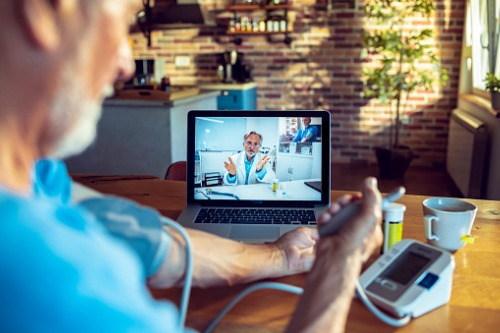

The “jury is out” in terms of how the unprecedent increase in telemedicine during the COVID-19 pandemic will impact the medical professional liability insurance market, according to Kanika Vats, director & actuary, healthcare practice leader at Aon Global Risk Consulting.
Telemedicine refers to a healthcare delivery model that uses electronic information and telecommunication technologies, connecting patients to healthcare services through videoconferencing, remote monitoring, electronic consultations and wireless communications. In the United States, the telemedicine market is expected to grow at a compound annual growth rate of 18.5% between 2019 and 2025, and is projected to surpass a valuation of $64 billion by 2025, according to a research report by Global Market Insights Inc.
While telemedicine capabilities have been around and growing for some time, they really burst on to the scene with more urgency in 2020 in response to the COVID-19 pandemic. Rather than risk further transmission of the coronavirus via in-person contact, many patients were encouraged to connect with their healthcare providers over virtual platforms like Skype, WebEx and Zoom, especially in the early months of the pandemic.
While telemedicine is convenient and beneficial for public health and safety, there are a number of liability issues that arise, especially regarding medical malpractice, potential misdiagnosis, and errors & omissions (E&O).
In a recent essay penned by Aon Global Risk Consulting and The Doctors Company, entitled: ‘Managing the medical professional liability risk of telemedicine claims: A data analytics and risk control perspective,’ experts, including Vatz, reflect: “While medical malpractice claims associated with this service have been minimal to date, we anticipate telemedicine-related claims to grow exponentially as an increasing number of providers add telemedicine to their healthcare delivery systems.”
Vatz told Insurance Business the “jury is still out” regarding the impact of telemedicine on medical malpractice claims and costs. She said: “[Through to October], the claims that Aon and The Doctors Company saw were low in both frequency and severity. However, as the usage of telemedicine grows, which it is expected to even after the pandemic subsides, the frequency of claims will increase, and we will see more claims related to telemedicine coming to the fore.
“In terms of the severity of those claims, again, I would say that the jury is still out. How probable is it to have a multi-million-dollar claim related to telemedicine? It’s hard to say. It goes back to the questions of: What is telemedicine? What kind of healthcare services are being provided by telemedicine? For example, you’re not going to have a baby being delivered over a video screen – and obstetrics is where we tend to see some of the largest claims.”
As revealed in Aon’s ‘Hospital and Physician Professional Liability Benchmark Analysis 2020,’ The Doctors Company’s data shows that of 27,559 medical professional liability claims that closed between 2007 and 2018, just 38 claims involved telemedicine. Aon also reviewed its database to see if it could identify any common coding nomenclature that would enable an actuarial analysis of telemedicine claims, but the broker found that none of the 108 US healthcare systems its dataset represents coded telemedicine claims the same way.
With rapid growth of the telemedicine business more or less set in stone, Aon Global Risk Consulting and The Doctors Company have stressed the importance of providers establishing a telemedicine claim coding taxonomy to capture liability claims pertaining to telemedicine exposures. They write: “Our hope is to steer the industry towards adopting a common coding structure to establish telemedicine datasets that are actionable, comparable and can be analyzed in future benchmark analyses.
“Our hypothesis is that by capturing future telemedicine claims using a common nomenclature, the underlying data points will provide the necessary information to propel effective risk management strategies that mitigate future HPL and PPL costs. Furthermore, this data will also enable a national examination of telemedicine specific claims versus other, more traditional HPL and PPL claims.”
